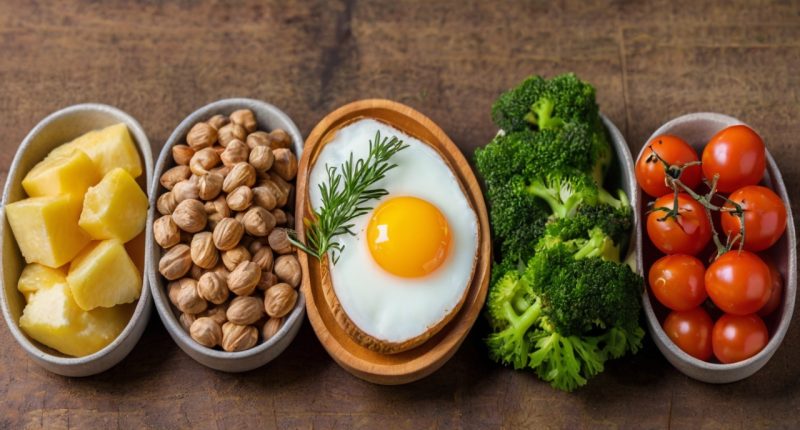Metabolism plays a vital role in how the body processes energy and burns fat. When the metabolic rate is elevated, the body can more efficiently convert food into energy, aiding in weight loss and overall health. Certain metabolism-boosting foods, such as protein-rich options, green tea, spicy ingredients, and high-fiber foods, can help enhance this process. Protein increases the thermic effect of food, meaning the body uses more energy to digest it, which supports fat loss. Similarly, green tea contains catechins that enhance fat oxidation, while spicy foods like chili peppers boost metabolism through their active compound, capsaicin. High-fiber foods aid digestion and stabilize blood sugar levels, contributing to a leaner body.
Table of Contents
Guide: Metabolism and Fat Burning?
Metabolism refers to the series of chemical processes by which your body converts what you eat and drink into energy. This process is essential for sustaining all bodily functions, including breathing, circulation, and digestion. It’s typically divided into two main categories: catabolism and anabolism. Catabolism involves breaking down food and nutrients to release energy, while anabolism uses that energy to build and repair tissues.
Fat burning, on the other hand, is a specific aspect of metabolism that focuses on how efficiently your body utilizes fat stores for energy. When your body is in a calorie deficit—meaning you consume fewer calories than you burn—fat stores become a primary energy source. This process is influenced by various factors, including hormones, enzyme activity, and the type of foods you eat.
Several elements can significantly influence metabolic rate and fat burning, such as age, muscle mass, and activity level. For instance, individuals with higher muscle mass typically have a faster metabolism because muscle tissue burns more calories at rest compared to fat tissue. Additionally, engaging in regular physical activity, particularly strength training and high-intensity interval training (HIIT), can also elevate metabolic rate and promote fat burning.
Combining a well-rounded diet that includes specific foods known to enhance metabolism with a regular exercise regimen can lead to effective fat loss and improved overall health. Understanding how metabolism works enables individuals to make informed dietary choices that support their weight management goals.
The Role of Protein in Boosting Metabolism
Protein plays a crucial role in boosting metabolism and aiding in fat burning. One of the primary reasons for this is its high thermic effect. The thermic effect of food (TEF) refers to the energy required for digestion, absorption, and metabolism of nutrients. Protein has a higher thermic effect compared to fats and carbohydrates, meaning that your body burns more calories digesting protein than it does for other macronutrients.
Alongside this, incorporating protein into your diet can lead to increased satiety. Foods high in protein can help you feel fuller for longer periods, which may reduce overall calorie intake. This can be particularly beneficial for those looking to lose weight or maintain a healthy diet.
Protein is essential for muscle repair and growth. Higher muscle mass is associated with a higher resting metabolic rate, meaning that those with more muscle will burn more calories at rest. Therefore, including adequate protein in your diet not only supports metabolic processes but also promotes muscle preservation during weight loss.
Some excellent sources of protein include:
- Lean meats (chicken, turkey, beef)
- Fish and seafood
- Legumes (beans, lentils, chickpeas)
- Dairy products (Greek yogurt, cottage cheese)
- Plant-based proteins (tofu, tempeh, edamame)
In conclusion, prioritizing protein in your diet can significantly contribute to boosting your metabolism and enhancing fat-burning processes, making it a vital component of a healthy eating plan.
Beneficial Effects of Green Tea on Metabolism
Green tea has gained popularity not only for its refreshing taste but also for its plethora of health benefits. One of the most notable advantages of green tea is its potential to boost metabolism and facilitate fat burning. This is primarily due to the presence of catechins, a type of antioxidant that plays a significant role in enhancing metabolic rates.
Research indicates that the consumption of green tea can lead to increased energy expenditure. Studies show that individuals who consume green tea extract may experience an uptick in their metabolic rate, primarily during the resting phase. This effect can help in burning additional calories throughout the day, contributing to weight loss and maintenance.

Another mechanism by which green tea aids metabolism is through its ability to enhance fat oxidation. Several studies suggest that the catechins present in green tea promote the breakdown of fat and its subsequent utilization for energy, especially during exercise. When paired with physical activity, green tea may help individuals maximize their fat-burning potential.
In addition to its direct effects on metabolism, green tea can also support better blood sugar regulation, which is crucial for maintaining healthy energy levels and preventing fat accumulation. By promoting stable blood sugar levels, green tea can help reduce cravings for high-calorie foods, further assisting weight management efforts.
To fully reap the benefits of green tea, consider incorporating it into your daily routine. Whether through brewed tea, matcha, or supplements, this natural beverage can be a valuable ally in your metabolism-boosting journey.
Spicy Foods and Their Thermogenic Properties
Spicy foods, particularly those containing chili peppers, have gained attention for their ability to increase metabolism and aid in fat burning. The key compound responsible for these effects is capsaicin, which is found in chili peppers. Capsaicin has been shown to enhance energy expenditure and promote a thermogenic effect, meaning it can raise body temperature and stimulate calorie burning.
When consumed, spicy foods can lead to a temporary increase in metabolic rate. This is due to the body working harder to process the capsaicin, thus utilizing energy in the form of calories. Studies suggest that incorporating capsaicin and other spices into meals can help support weight management efforts while adding flavor to dishes.
In addition to enhancing metabolism, spicy foods may also contribute to appetite control. Research indicates that consuming spicy meals can lead to reduced calorie intake, as it often promotes a feeling of fullness more quickly. This combination of increased energy expenditure and decreased hunger makes spicy foods a valuable addition to a fat-burning diet.
Moreover, other spices such as ginger, black pepper, and turmeric also exhibit thermogenic properties that can further support metabolic health. Including a variety of these spices in your meals not only boosts flavor but can also enhance your efforts in burning fat and increasing overall metabolism.
The Impact of High-Fiber Foods on Metabolism
Incorporating high-fiber foods into your diet can significantly enhance your metabolism and aid in fat burning. Fiber plays a crucial role in overall digestive health and can influence metabolic processes in several ways.
1. Enhancing Satiety
High-fiber foods promote feelings of fullness, which can help control appetite and reduce overall calorie intake. When you consume fiber-rich foods, they absorb water and expand in the stomach, prolonging satiety and preventing overeating.
2. Improving Digestion
Fiber supports digestive health by promoting regular bowel movements and a healthy gut microbiome. A well-functioning digestive system is essential for effective nutrient absorption and energy expenditure, both of which contribute to a healthy metabolism.
3. Increasing Energy Expenditure
The thermic effect of food (TEF) is the energy required to digest, absorb, and process nutrients after a meal. High-fiber foods generally require more energy to break down compared to processed foods. By incorporating these into your meals, you can increase the TEF and, consequently, your metabolic rate.
4. Stabilizing Blood Sugar Levels
Fiber helps slow the absorption of sugar into the bloodstream, leading to more stable blood sugar levels. This stabilization can prevent the spikes and crashes associated with high-sugar meals, reducing cravings and promoting a more balanced energy expenditure throughout the day.
5. Key High-Fiber Foods to Consider
- Fruits (e.g., apples, pears, berries)
- Vegetables (e.g., broccoli, carrots, spinach)
- Whole grains (e.g., quinoa, oats, brown rice)
- Legumes (e.g., lentils, beans, chickpeas)
- Nuts and seeds (e.g., chia seeds, flaxseeds, almonds)
By adding more high-fiber foods to your daily diet, you can not only improve your metabolism but also achieve better overall health. Consider these foods as part of your meals and snacks to harness the benefits of fiber for enhanced fat burning and metabolic efficiency.
Metabolism-Boosting Foods to Add to Your Diet
If you’re looking to give your metabolism a natural boost, incorporating specific foods into your diet can make a significant difference. Here’s a list of metabolism-enhancing foods that you can consider including in your meals:
- Leafy Greens: Vegetables such as spinach, kale, and Swiss chard are rich in nutrients and low in calories. They provide essential vitamins that aid metabolic processes.
- Lean Meats: Chicken breast, turkey, and lean cuts of beef are excellent sources of protein, which have a higher thermic effect compared to fats and carbohydrates, meaning you’ll burn more calories during digestion.
- Eggs: Packed with high-quality protein, eggs also contain essential vitamins and minerals. They help you feel full longer, which can contribute to overall weight management.
- Quinoa: This whole grain is not only a complete protein source but is also rich in fiber, which can help regulate metabolism and promote digestive health.
- Nuts and Seeds: Almonds, walnuts, flaxseeds, and chia seeds are nutrient-dense and contain healthy fats that assist in metabolic function. They also help keep you satiated.
- Berries: Blueberries, strawberries, and raspberries provide antioxidants and fiber, while being low in calories. These fruits can contribute to fat loss and improved metabolic rates.
- Oily Fish: Salmon, mackerel, and sardines are high in omega-3 fatty acids, which can enhance metabolic processes and promote fat oxidation.
- Whole Grains: Foods like brown rice, oats, and whole wheat bread support a healthy metabolism due to their fiber content, which aids in digestion and regulates blood sugar levels.
- Citrus Fruits: Oranges, lemons, and grapefruits are not only refreshing but also contain vitamin C and fiber, which are beneficial for metabolic health.
- Greek Yogurt: This protein-rich dairy product supports muscle growth and fat loss, making it an excellent addition to boost metabolism.
Incorporating these foods into your daily meals can help enhance your metabolic rate and support overall fat-burning efforts. Remember, maintaining a balanced diet along with regular exercise plays a crucial role in achieving your health and weight loss goals.
Frequently Asked Questions
What are some foods that can help boost metabolism?
Foods rich in protein, like lean meats, eggs, and legumes, can help boost metabolism due to the higher energy required for digestion. Spicy foods containing capsaicin, such as chili peppers, can also temporarily increase metabolic rate.
How do green tea and coffee affect metabolism?
Green tea and coffee contain caffeine and antioxidants that can enhance metabolic rate and fat oxidation. They may also help improve physical performance.
What role does protein play in metabolism?
Protein has a higher thermic effect compared to fats and carbohydrates, meaning it requires more energy for digestion and absorption. This can lead to an increase in overall calorie burn.
Are there any specific vitamins or minerals that boost metabolism?
Certain vitamins and minerals, such as B vitamins, iron, and magnesium, play a crucial role in energy production and metabolism. They help convert food into usable energy.
Can dairy products contribute to fat burning?
Yes, dairy products like yogurt and cheese can contribute to fat burning. They are high in protein and contain calcium, which may play a role in fat metabolism.
Is it true that drinking water can increase metabolism?
Drinking cold water can temporarily boost metabolism because the body uses energy to heat the water to body temperature. Staying hydrated is also essential for overall metabolic functions.
How important is meal timing in relation to metabolism?
Meal timing can influence metabolism. Eating small, balanced meals throughout the day can prevent metabolic slowdown and maintain energy levels, promoting consistent fat burning.





